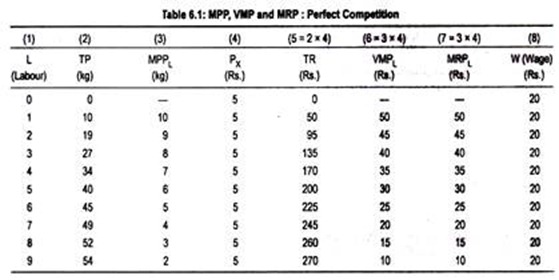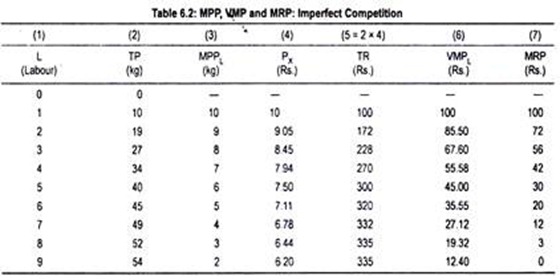The following points will highlight the three main concepts of Marginal Product (MP). The concepts are: 1. MPP 2. VMP 3. MRP.
MP Concept # 1. MPP:
MPP is the change in total product consequent upon a change in the use of an input. For the sake of analysis, we assume that our firm uses labour as a variable input and all other inputs are held constant. Thus, MPP of labour, or symbolically, MPPL is, the change in total product (TP) due to a change in the use of labour, i.e.,
MPPL = change in total product/change in number of labour
or, MPPL = ∆TP/∆L
MP Concept # 2. VMP:
ADVERTISEMENTS:
When MPP is expressed in monetary term we obtain VMP.
If we multiply MPP by the price of the good, say X, (PX), we obtain the money value of MPP:
VMP = MPP × PX
Assuming labour as the variable input,
ADVERTISEMENTS:
VMPL = MPPL × PX
MP Concept # 3. MRP:
MRP is the change in total revenue resulting from the employment of additional unit of a variable input in question. In other words, MRP of labour is the change in total revenue attributable to a change in the employment of labour, i.e.,
MRPL = change in total revenue/change in number of labour
or, MRPL = ∆TR/∆L
ADVERTISEMENTS:
MRP may also be defined as the MPP of the variable input multiplied by marginal revenue (MR). In terms of labour,
MRPL = MPPL × MR
An Illustration of the Concepts:
To have a clear understanding of these concepts, we have constructed two tables— one for perfect competition and another for imperfect competition. In these tables, we assume labour as the variable input while other inputs are held constant. We also assume that labour, along with other fixed inputs, produce good X.
If we assume that the market for good X resembles perfect competition, then price of the product X remains invariant. It is also assumed that labour market is characterized by perfect competition. This means that, at a given wage rate, any amount of labour may be supplied. Let the price of the product X be Rs. 5 and the wage rate be Rs. 20.
According to Table 6.1, for all units of labour employed, VMPL = MRPL. If perfect competition exists in the product market, VMPL coincides with the MRPL (since AR = MR).
However, if perfect competition does not exist, we reach a different conclusion. Under imperfect competition, a seller can influence the price of the product that he sells in the market.
In other words, as a monopoly seller or a monopolistically competitive seller behaves as a price-maker, price of the commodity does not remain constant. Under the circumstance, as AR > MR, VMPL must exceed MRPL. This is shown in Table 6.2.
In this table, price of X is not fixed. Since, under imperfect competition, P = AR > MR, VMP diverges from MRP for all units of labour. To be more specific, VMPL> MRPL. Above all, MRPL can be zero and negative.
In this connection, it may be referred that, under perfect competition, VMPL = MRPL is the firm’s demand curve for labour. This curve is drawn negatively sloped. This means that, at a high wage, less labour, and, at a low wage, more labour is demanded.
On the other hand, under imperfect competition as VMP exceeds MRP, the VMP curve must lie above the MRP curve. Further, MRPL curve—not the VMPL curve—is the firm’s demand curve for labour.

